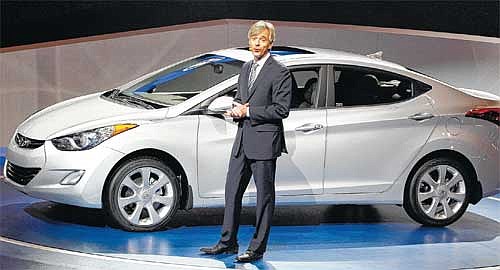Hyundai Motor America is squeezing as much production as possible out of its facilities in the United States, but it will not be enough to meet demand, CEO John Krafcik told dealers at a J.D. Power and Associates conference in Las Vegas on Friday.
The math is clear: Hyundai made about 420,000 vehicles in the U.S. last year: 330,000 at its plant in Alabama and another 90,000 from the sister Kia plant in Georgia.
But Hyundai sold about 640,000 vehicles here and is a believer in building where you sell, Krafcik said.
Last year, through improvements to the Alabama plant, Hyundai was able to boost capacity from 300,000 to 330,000 - a 10 percent increase in productivity for relatively low investment, Krafcik said.
The automaker will look for similar ways to boost production in Georgia, too, he said, but he doesn't expect a 10 percent boost is again possible.
"We have no plans to build a new plant at this time," the CEO said.
Krafcik said he continues to ask for more vehicles from headquarters in South Korea, but that the automaker is keeping capacity limited as it works to mitigate risks associated with global growth.
"We are worried at a time of great growth to make a mistake on the quality side," he said of the automaker's deliberate decision to give up short-term volume and sales gains for long-term strength of the brand.
Toyota was a cautionary tale when a series of recalls was blamed, in part, on rapid growth that stretched resources of the traditionally conservative company.
Despite the capacity constraints, Hyundai expects incremental sales in the U.S. in 2012, led by the Azera and new Veloster.
John Humphrey, general manager of the Global Automotive Division of J.D. Power, said North American light vehicle sales should grow 8 percent this year to 16.4 million. Of that, 13.8 million will be in the U.S., and it will increase to 16.5 million in 2015.
Globally, sales should reach 79 million this year and grow to 99 million in 2015. Humphrey said the industry as a whole is better matching production to demand.
And inventory shortages have made it easier to hold the line on both incentives and fleet sales which combine for higher average transaction prices.
"We used to be convinced you couldn't sell a car without a rebate," he said. That has changed.
Krafcik said only 18 percent of cars sold in the U.S. last year had a rebate - that figure has been 70 percent or higher in the past - and the average was $1,005. In January, the figure fell to an average amount of $859.
On the retail side, 375 of Hyundai's 815 U.S. dealers will complete facility upgrades by the end of the year, representing about 70 percent of sales volume. The average investment is $900,000 with new signage and more inviting waiting rooms.
Hyundai wants dealers to use their judgment in choosing furniture and beverages while following general guidelines to make Wi-Fi available and create an inviting area.
"To make them identical doesn't make any sense," he said.
And "we are not specifying the type of grout to use in the bathroom," he said in a dig at the level of detail some automakers require from their dealers.
